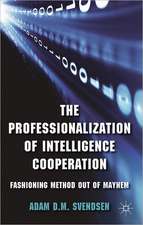Responding to the Threat of Violent Extremism: Failing to Prevent
Autor Paul Thomasen Limba Engleză Hardback – 12 sep 2012
Preț: 654.45 lei
Preț vechi: 838.31 lei
-22% Nou
Puncte Express: 982
Preț estimativ în valută:
125.24€ • 135.100$ • 105.20£
125.24€ • 135.100$ • 105.20£
Carte tipărită la comandă
Livrare economică 22 aprilie-06 mai
Preluare comenzi: 021 569.72.76
Specificații
ISBN-13: 9781849665254
ISBN-10: 1849665257
Pagini: 192
Dimensiuni: 156 x 234 x 20 mm
Greutate: 0.39 kg
Ediția:New.
Editura: Bloomsbury Publishing
Colecția Bloomsbury Academic
Locul publicării:London, United Kingdom
ISBN-10: 1849665257
Pagini: 192
Dimensiuni: 156 x 234 x 20 mm
Greutate: 0.39 kg
Ediția:New.
Editura: Bloomsbury Publishing
Colecția Bloomsbury Academic
Locul publicării:London, United Kingdom
Caracteristici
Draws on recent primary research, both by the author and academic colleagues, that to date has either not been published or has only reached limited audiences and uses it to propose specific directions for future policy
Notă biografică
Paul Thomas is Reader in Youth and Education at the School of Education and Professional Development, University of Huddersfield, UK.
Cuprins
Contents Acknowledgements Preface Glossary Introduction: A new threat of violent extremism? The Policy response of Prevent The purpose of this Book The Structure of the Book Issues of Terminology 1. The Threat of Violent Extremism Introduction: 'Terrorism'? 7/7: Home-grown suicide bombers Radical Islam: the 'single narrative' A reaction to British Foreign Policy? A Foreign Hand? Ethnic Segregation, Poverty and Marginalisation? Radicalisation: Mosques, 'preachers of hate' and recruiters? Group Dynamics Conclusion: No easy answers 2. Community Cohesion: A changed policy context Introduction: The changed policy context of Community Cohesion The 2001 Riots and their aftermath The emergence of Community Cohesion Community Cohesion in practice Refusing Brutishness? Problematic Muslim Identity? A Minority of lslamist extremists 3.Preventing Violent Extremism Introduction: States responding to terror A lethargic response? Pre 7/7 developments 'Preventing Extremism Together' 'Preventing Violent Extremism' Preventing Violent Extremism in practice Prevent under Pressure Coalition Government: A new approach? The Revised Prevent Strategy Conclusion: Prevent - flawed and friendless? 4. British Muslims: A Suspect Community? Introduction: Muslims under the spotlight A monocultural contradiction to Community Cohesion? Clumsy 'Social Engineering' Learning from the experience of anti-racist education Disinterest in far-right extremism Conclusion: Some Communities are suspect? 5. Confusion on the Ground: Prevent in operation Introduction: Orders from above Local Authorities and Prevent Local Variations Not all bad news? Professionals in the spotlight? Summing up: Local Authorities in a bind? Extremists on Campus? Prisons and Young Offenders Conclusion: Local Complexity 6. Spooks? Introduction: Education or Surveillance? CONTEST and the growth of the security state RICU: Massaging the message? 'Spooked': Allegations and responses Channel: A way forward? Conclusion: Perception is everything?
Recenzii
Paul Thomas writes in an accessible and persuasive manner, with arguments expertly and attractively presented. The topic itself is of utmost policy significance. This book fills a gap in a field marked by a lack of serious, research-based treatments.
This book provides a clearly written and confidently argued account of mainly British debates over how to respond to violent extremism. It draws on some new research evidence and makes a valuable contribution to our knowledge and understanding of this topic... with much insight and a wealth of detail informed by a strong critical voice.
The book offers a useful and detailed discussion of the myriad of issues relating to this subject and succeeds in ploughing a focussed furrow through what is a potentially mammoth and controversial subject. Clear signposting and useful chapter summaries makes this a useful reference book.
The book provides an informative and readable account of the development and implementation of the Prevent strategy, that serves a readership interested in state approaches to 'soft-security' well by providing a clear overview of the history of Prevent and engaging extensively with very recent changes under the present Coalition government. ... The book will be a very useful addition to the fields of state-Muslim relations, the governance of ethnic and religious diversity, counter-terrorism and politics of race, ethnicity and religion.
This book provides a clearly written and confidently argued account of mainly British debates over how to respond to violent extremism. It draws on some new research evidence and makes a valuable contribution to our knowledge and understanding of this topic... with much insight and a wealth of detail informed by a strong critical voice.
The book offers a useful and detailed discussion of the myriad of issues relating to this subject and succeeds in ploughing a focussed furrow through what is a potentially mammoth and controversial subject. Clear signposting and useful chapter summaries makes this a useful reference book.
The book provides an informative and readable account of the development and implementation of the Prevent strategy, that serves a readership interested in state approaches to 'soft-security' well by providing a clear overview of the history of Prevent and engaging extensively with very recent changes under the present Coalition government. ... The book will be a very useful addition to the fields of state-Muslim relations, the governance of ethnic and religious diversity, counter-terrorism and politics of race, ethnicity and religion.
Descriere
Home-grown terrorism was responsible for the 7/7 London bombings and a number of subsequent plots. Using empirical evidence, this book highlights the misguided and ineffective efforts of the UK government to 'prevent violent extremism', particularly amongst young Muslims, and proposes alternative policy approaches to combat terrorism.


















